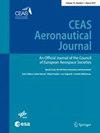完全建立的跨音速冲击条件下湍流尾流的实验研究
Q2 Engineering
引用次数: 0
摘要
跨声速飞行常以跨声速冲击为主,这是一种涉及流场大部分的高度非定常复杂的激波/边界层相互作用。该现象与压缩激波的大振幅周期性运动相关联,并伴有大规模的流动分离和间歇性的再附着。由于整体流动拓扑结构的大规模变化,翼型或机翼的湍流尾迹也受到严重影响,尾迹撞击下游的任何气动装置也受到严重影响。为了分析和理解尾迹的湍流结构和动力学,在弦雷诺数为$$2\times 10^{6}$$ 2 × 10.6的跨声速冲击条件下,对超临界OAT15A翼型近尾迹进行了全面的实验研究。速度场测量结果表明,颤振模式对翼型吸力侧和尾迹的表面约束流场都有严重的全局影响。气流是间歇性的强烈分离,有一个明显的动量赤字延伸到尾流。从以雷诺剪切应力和rms值表示的相平均湍流量可以看出,射流的冲击运动引起了紊流的剧烈扰动和变化。利用高速聚焦纹影序列分析了下游对流波动和湍流结构的光谱性质。对后缘直接附近旋涡脱落的功率谱密度的分析表明,主导频率比与冲击冲击相关的频率高一个数量级($$St_c=\mathcal {O}({1})$$ S t c = O (1)) vs. $$St_c=\mathcal {O}({0.1})$$ S t c = O(0.1))。结果表明,剪切层的扑动运动伴随着强度波动的von Kármán-type涡街的形成。这些尾流结构和动力学将影响任何受尾流影响的下游气动装置。因此,我们的研究可以得出关于诸如尾翼等设备的流入流的结论。本文章由计算机程序翻译,如有差异,请以英文原文为准。
Experimental investigation on the turbulent wake flow in fully established transonic buffet conditions
Abstract The transonic flight regime is often dominated by transonic buffet, a highly unsteady and complex shock-wave/boundary-layer interaction involving major parts of the flow field. The phenomenon is associated with a large-amplitude periodic motion of the compression shock coupled with large-scale flow separation and intermittent re-attachment. Due to the resulting large-scale variation of the global flow topology, also the turbulent wake of the airfoil or wing is severely affected, and so are any aerodynamic devices downstream on which the wake impinges. To analyze and understand the turbulent structures and dynamics of the wake, we performed a comprehensive experimental study of the near wake of the supercritical OAT15A airfoil in transonic buffet conditions at a chord Reynolds number of $$2\times 10^{6}$$ 2 × 10 6 . Velocity field measurements reveal severe global influences of the buffet mode on both the surface-bound flow field on the suction side of the airfoil and the wake. The flow is intermittently strongly separated, with a significant momentum deficit that extends far into the wake. The buffet motion induces severe disturbances and variations of the turbulent flow, as shown on the basis of phase-averaged turbulent quantities in terms of Reynolds shear stress and RMS-values. The spectral nature of downstream-convecting fluctuations and turbulent structures are analyzed using high-speed focusing schlieren sequences. Analyses of the power spectral density pertaining to the vortex shedding in the direct vicinity of the trailing edge indicate dominant frequencies one order of magnitude higher than those associated with shock buffet ( $$St_c=\mathcal {O}({1})$$ S t c = O ( 1 ) ) vs. $$St_c=\mathcal {O}({0.1})$$ S t c = O ( 0.1 ) ). It is shown that the flapping motion of the shear layer is accompanied by the formation of a von Kármán-type vortex street of fluctuating strength. These wake structures and dynamics will impact any downstream aerodynamic devices affected by the wake. Our study, therefore, allows conclusions regarding the incoming flow of devices such as the tail plane.
求助全文
通过发布文献求助,成功后即可免费获取论文全文。
去求助
来源期刊

CEAS Aeronautical Journal
Engineering-Aerospace Engineering
CiteScore
3.40
自引率
0.00%
发文量
53
期刊介绍:
The CEAS Aeronautical Journal has been created under the umbrella of CEAS to provide an appropriate platform for excellent scientific publications submitted by scientists and engineers. The German Aerospace Center (DLR) and the European Space Agency (ESA) support the Journal.The Journal is devoted to publishing results and findings in all areas of aeronautics-related science and technology as well as reports on new developments in design and manufacturing of aircraft, rotorcraft, and unmanned aerial vehicles. Of interest are also (invited) in-depth reviews of the status of development in specific areas of relevance to aeronautics, and descriptions of the potential way forward. Typical disciplines of interest include flight physics and aerodynamics, aeroelasticity and structural mechanics, aeroacoustics, structures and materials, flight mechanics and flight control, systems, flight guidance, air traffic management, communication, navigation and surveillance, aircraft and aircraft design, rotorcraft and propulsion.The Journal publishes peer-reviewed original articles, (invited) reviews and short communications.
 求助内容:
求助内容: 应助结果提醒方式:
应助结果提醒方式:


